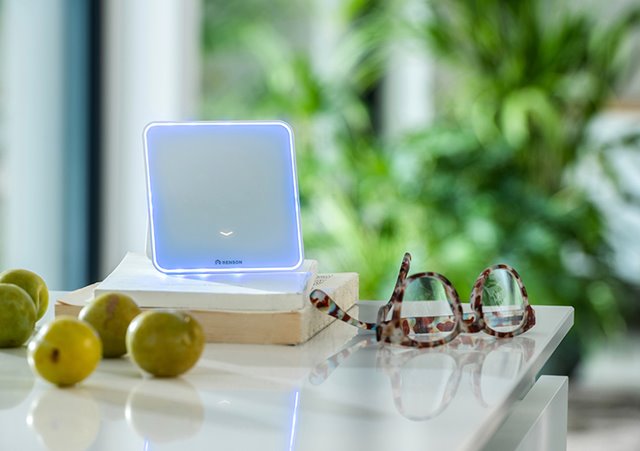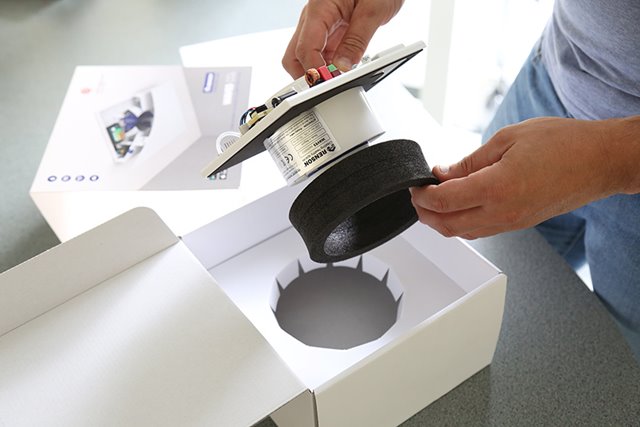Energy tips? Yes please, but not at the expense of indoor health
Continue ventilating, even in winter
As energy prices increases, so do the number of savings tips. Those well-meaning recommendations are certainly helpful. But please make sure they don’t put your health at risk by turning your home into an airtight “thermos”. In other words, you really need to make sure you always have sufficient fresh air in your home. Our 5 tips are designed to offer you some advice about how to do this in the most energy-efficiently way possible, even in winter:
1. Turning the heating down & closing all the windows and doors is just asking for moisture problems
The first tip offered by well-meaning “experts” at the onset of every winter (and certainly this one) is to turn your heating down a degree. That’s the way it should be! After all, it’s nothing an extra pullover or fleece blanket can’t fix. Most people make sure the temperature doesn't drop below 16°C anyway. But if you combine that with keeping your home hermetically sealed and closing up all possible cracks or crevices, you are asking for trouble. You may be lucky enough that your actions result in a lower energy bill, but you need ventilation if you are to maintain the indoor air quality at a sufficient level. And this is especially true when the temperature drops – with the associated increased chance of condensation – because poor air circulation will cause moisture to accumulate in the indoor air (and in the walls of your home). This results in the formation of mould, which not only has a harmful impact on your home, but can also contribute to poor health for you and your fellow residents. In England recently, a two-year-old child died of a respiratory infection caused by mould in the home.
Is your home equipped with a well fitted and well maintained ventilation system? Luckily this will intervene when it detects excess humid interior air (as well as an excess of CO2 and odours) to remove it in good time and replace it with fresh air from outside. Without it the moisture would unfortunately not be able to find a way out, resulting in it accumulating in the house. Would you like to know more about the moisture content in your home and what measures to take? A measuring device such as the Renson Sense not only measures CO2 in the interior air, it also measures the moisture content.
2. Window open? Not the best idea!
Do you want to get some fresh inside your home? Opening a window is a temporary solution, but never provides the necessary throughput to keep sufficient fresh air in the house. During the winter, letting cold exterior air in not only causes a sudden loss of the heat in the house, it increases the risk of condensation and mould formation in homes without a well functioning ventilation system. Continuous and controlled ventilation is the only way to enjoy sufficient fresh air in your home 24/7, and to do so in an energy-efficient way. Did you know that central “demand-driven” ventilation systems are now designed to work so energy efficiently that they barely have an impact on your energy bill? How? They are continuously monitoring indoor air quality, which means they only ventilate where and when it is really necessary; for example, in a busy bathroom in the morning and/or in a bedroom at night. And as economical as they are, they are still able to automatically offer a basic ventilation level in those rooms in the house without the system installed. This is a great bonus and means you never have to lose sleep over healthy indoor air.
3. Never turn off your ventilation system
As tempting as it may seem when you want to make savings on your energy bill: you should never switch off the ventilation system or fully close your window vents (that provide a supply of fresh air from outside). You don’t want to risk your own health or that of your house-mates, do you? Because that’s the risk you are taking. The average family produces 10 litres of moisture per day in the house just by cooking, washing, going to the bathroom, etc., and that even includes breathing. You also risk the accumulation of dirt particles and odours from construction, decoration and cleaning products, dust mites and animal hair in the indoor air. This why it can sometimes smell so musty after a night with 2 people sleeping in a small bedroom without ventilation. Now we are living and working indoors more than we would in the spring and summer, it is even more crucial to reflect on this (did you know we spend no less than 90% of our time indoors?). For those aware of this, but prefer not to worry about it, there is good news: a Renson demand-driven ventilation systems will do the work for you. They ensure the indoor air quality remains as good as possible at all times and in the most energy-efficient way, without you even realising it.
4. To measure is to know

We exhale CO2 every time we breathe. If you have a whole family in an airtight house without a sufficient ventilation system, or one that does not work properly, the CO2 will not be able to find a way out and the levels of this poisonous gas will build up. Consequences? Headache, fatigue, drowsiness, poor sleep, respiratory infections, etc. are all ailments you may never really know what the cause was. Happily modern ventilation systems monitor that CO2level 24/7 and automatically adjust the ventilation levels accordingly, preferably in each room in the house. Is your home not equipped with a ventilation system? Then you can use a CO2 meter to measure the indoor air quality as a first step. After all, to measure is to know. Once you have carried out a few measurements, you will have a good baseline to draw the right conclusions and look for the right ventilation solution for your home. And even though CO2 is not the only measurement you can take, it is generally accepted as the best measure of value for good indoor air quality. Your device (such as the Renson Sense) can also measure other indoor climate parameters such as light, air, humidity, odour and moisture, so you will be even better informed about how healthy you are living.
5. A place for ventilation? So you thought

Are you struggling to see where you would install a central ventilation system in your home? Don’t worry, with a decentralised ventilation system, you can tackle the most critical (wet) areas. The good news is that even these ventilation systems can offer a fully automatic response in the room in question to the indoor air quality they are monitoring. This means you don’t have to worry about ventilation here either; the system works in the most energy-efficient way, which means you can always enjoy the best possible indoor air quality without having to manually control it, even in winter. After all, if moisture cannot find a way out of an airtight sealed home, it can cause condensation damage and a large formation of mould, not to mention reducing the quality of the indoor air that you breathe. Even Renson Waves is a handy alternative for bathroom fans that must be switched on and off manually. Not only to remove the excess moisture from wet areas, but also to keep the CO2 content under control in adjacent areas. Everything is controlled automatically using measurements taken by the built-in sensors.
To be sure you can enjoy good indoor air quality 24/7, a reliable ventilation system is the only way to go. After all, ventilation is now a mandatory requirement for new constructions and renovation projects for good reason. The new ventilation system work in the background to ensure the perfect coordination of extracting polluted indoor air and replacing it with a supply of fresh air from outside any time and in any room in the house, preferably tailored to your living needs and lifestyle. This means the home is actively “flushed” with fresh air so the inhabitants can always be sure of the best possible indoor air quality. It’s good for your health, and better still for your wallet.